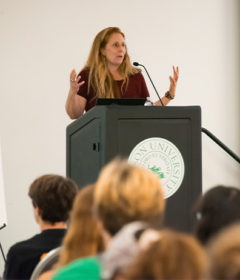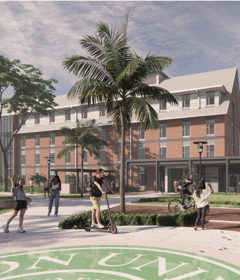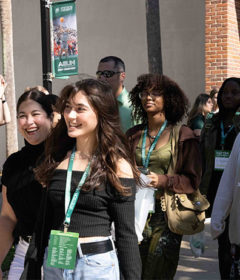Race, Higher Education flash panel sparked by MU protest
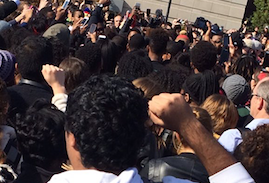
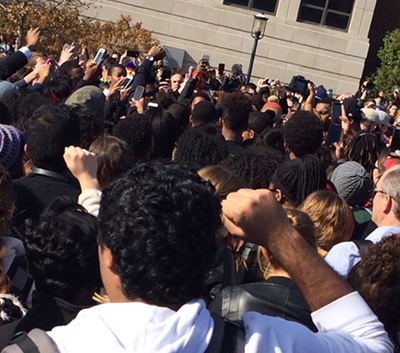
The events that sparked the protests at the University of Missouri (MU) ignited a flash panel discussion at Stetson University’s DeLand campus that was simultaneously streamed to the Stetson University College of Law in Gulfport, Fla., on Tuesday, Nov. 17. Opening remarks by Stetson President Wendy B. Libby, Ph.D., focused toward the goals of creating conversations and deliberation, with an audience largely made up of students, faculty and staff about the perspectives on the recent events around race in higher education.
Moderator Rosalie Richards, Ph.D., associate provost for Faculty Development, noted: “The issues discussed tonight may be sensitive but we invite suggestions.” Richards then introduced credible university resources on the panel: Oren Griffin, Esq., associate dean and professor of Law, Mercer University; Kimberly Flint-Hamilton, Ph.D., professor and chair, Department of Sociology and Anthropology; Michael McFarland, Ph.D., associate professor of Communication and Media Studies; Judith A. M. Scully, Esq., Wm. Reece Smith Jr. Distinguished Professor of Law and Chandler Steele, Stetson student and Community Engagement chair for the Black Student Association.
Beginning with a moment of silence for our French allies, the tone was set and then Flint-Hamilton laid the foundation of disturbing events that escalated with student-led protests at MU, calling for the resignation of Tim Wolfe, MU’s president and Chancellor R. Bowen Loftin. Students were backed by MU’s football team who vowed to strike, an act that would cost the school nearly a million dollars per game.
“These protests aren’t sudden,” said Flint-Hamilton. She added “The scattering of cotton balls outside of MU’s Black Culture Center, the killing of Michael Brown in not so distant Ferguson, Mo., and using feces and ashes to draw swastikas on black residence halls,” so emotions have been percolating.
Once they erupted, the protests happened quickly and included: student group Concerned Student 1950—named for the year African-American students were first admitted to MU—issued a list of demands seeking change at MU; protesters blocked Wolfe’s car during the MU homecoming parade to voice their concerns but Wolfe didn’t respond to their complaints and then MU grad student Jonathan Butler’s hunger strike that attracted national attention.
Griffin noted via Skype, “The nation is reflective of what goes on in colleges and universities; they don’t happen in isolation,” and questioned whether diversity is big enough saying, “maybe inclusion is a better word.”
After an historical overview based on white supremacy, panelist Scully in Gulfport asked: “How do we move to a colorblind society from this foundation?” Noting facts on the shifting population demographics in America, Scully added: “Where minority and majority are changing, it is in all our best interests to accommodate [the changes].”
It was McFarland who defined a protest movement continuum: how and where protests can begin effectively; where crises fall on the continuum; and when and how they begin to lose momentum once the crisis is considered “over.” McFarland noted: “There is an ‘ethics – persuasion line’ which runs from ethical to unethical,” and also spoke about the potential harm and usefulness of social media when rallying protest support. “Status quo means, if you do nothing, it stays the same; we have to have protests to make [a] change.”
The African proverb, “If you want to go quickly, go alone. If you want to go far, go together,” was quoted by Steele to provide insight into asking, “what is our responsibility,” in matters such as Missouri, which parleyed into Steele’s own reckoning, “Change takes persistence and sustainability.”
Richards then initiated an audience-led question session for the second half of the forum.
Stetson University student Tyler Thomas asked, “Do you think the race issues will be solved in our lifetime?”
McFarland answered, “We have to change heart and mind, and that takes time.”
The students at MU were reported to have said that caring, conversation and doing the right thing morally will move the issue forward in a positive way.
Gerardo Diaz echoed a Frederick Douglass quote, “It is easier to build strong children than repair broken men,” and said we, as a nation, should be concerned with our youth in the public schools.
When Shanita Smith asked, “How effective was Stetson’s own 2014 Black Lives Matter rally,” Flint-Hamilton pointed out the importance of the seeds that were planted caused some significant curricular changes, and said she thought that is important progress.
Student Trinity Johnson, president of Black Student Association, brought a different viewpoint to the discussion, saying, “I’m not after a post racial society,” because it erases black culture and experiences. “I’m after inclusion and acceptance.” McFarland gave this response, “It would be great in protests and rallies if logic and reasoning would prevail because with protest after protest after protest etc., people start to not listen.”
A simultaneous flash panel at the College of Law was moderated by Judith A. M. Scully, Esq., the Wm. Reece Smith Jr. Distinguished Professor of Law.
In her concluding remarks, Lua Hancock, Ed.D., vice provost, said, “This is our work, and it will not stop with tonight.” A follow-up session will be scheduled to strategically plan and take action to make Stetson a more inclusive environment. Watch for more information in Stetson Today, as plans are confirmed. For more information contact Hancock at [email protected].
By Caroline Skinner

